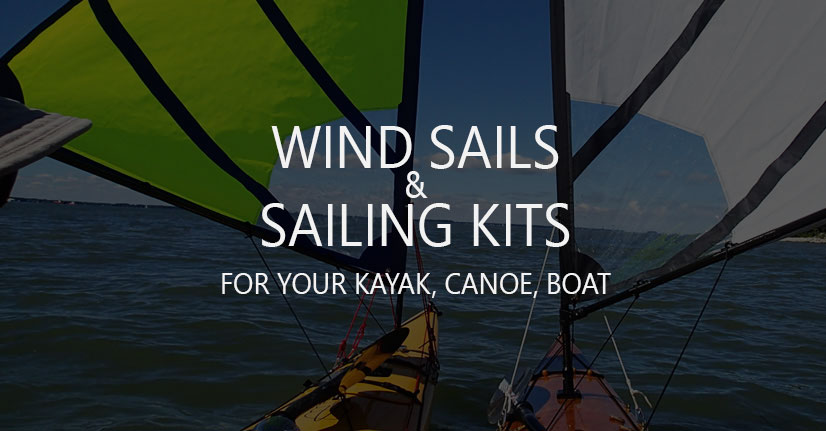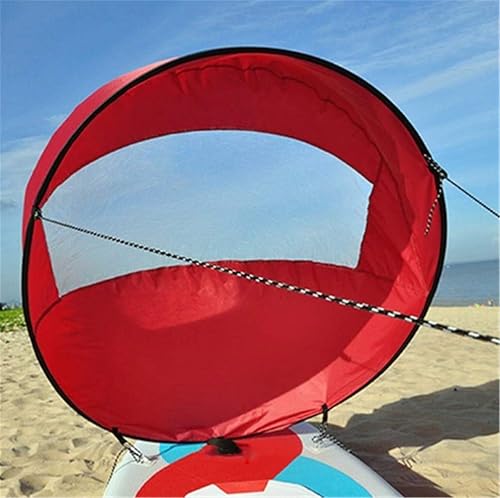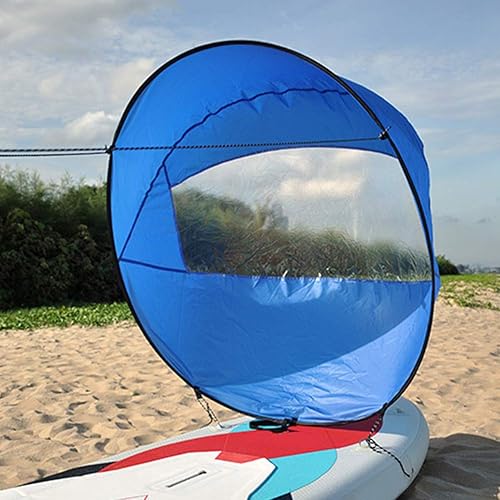Kayak folding sails are ingenious accessories designed to harness the power of the wind, transforming your kayak into a small sailboat. Compact and easy to use, these sails are perfect for enhancing your kayaking adventures. They’re lightweight and portable, folding down to a manageable size for storage and transport. When deployed, kayak folding sails provide an exhilarating way to cover more distance with less effort, making long journeys or leisurely cruises a breeze. Most models are adjustable, allowing you to control the sail’s angle and harness optimal wind conditions. Experience the thrill of sailing on your kayak with these innovative folding sails.
Things to consider before buying kayak wind sails
Eco-friendly Materials
first thing to consider is the material used in the product. Nowadays there is a great variety of materials to choose from, which can make your decision difficult. It is very important for the material to be both light and strong. best example of this would be polyester taffeta (sail cloth), which is an extra-strong and light composite. Another thing you should bear in mind is the quality of the seams on joints.
Installation
most important matter is the attachable equipment used for installation. You must pay attention not only to joint seams, their quality and additional reinforcement, but also to the way the sail is installed on the boat. All straps and hooks must be both extremely strong and light, providing reliable fastening.
Sail Compatibility with Boat
When choosing a sail, be sure that it fits your boat. There are several factors to consider:
- fastenings
- method of sailing
- sail design
It is also important to pay attention to whether a sail restricts visibility or not, as you always need to see where the boat is sailing. We have selected various options for removable canoe, kayak, and inflatable boat sails. They have various mounting options, as well as designs and ways of sailing. With the proposed choice, you can find the best option that meets your requirements. All models have a special, transparent area for excellent visibility in all directions.
Sail shapes
When you’re getting your first wind sail, you might very well be confused by all the different shapes of sails available. Until you know what each shape’s pros and cons are, and what you need for your specific purpose, you can’t really make an informed decision. There are four general shapes of sail, and they’re usually suitable for different skill levels. Let’s take a look at all of them.
Circle-shaped sails
Circle-shaped sails are the most common ones, and they’re ideal for beginners. They’re usually made out of a type of plastic, and they have a transparent visor in the middle. visor is tricky, because the bigger it is, the better you can see, but the material can be damaged by the sun. rest is a circle parachute that has hooks. These hooks are used so you can attach the sail to your kayak. The best thing about circle-shaped sails is that you can use it on just about any kind of kayak. They’re also very easy to install and set up, all you need to do is clip it on and prop it up. wind will take care of everything else. However, one potential downside is speed. Circle-shaped sails aren’t really very fast, and this is more or less their only bad thing.
V-shaped sails
V-shaped sails are the next option, and they’re an overall improvement of circle sails. They weren’t popular until a few small manufacturers such as Falcon Sails decided to use higher-quality materials and make them much better. This resulted in high-quality sails that perform similarly to circle-shaped sails but are in a different shape. material is also different, and v-shaped sails are generally made more durable. You still get the visor in the middle which allows for visibility up front. Their biggest con is the size, as they’re generally smaller than circle-shaped sails, and therefore grab much less wind. They compensate for this by adding high-quality materials, so it’s a tradeoff some would think is very much worth it.
V-shaped parachute sails are also good for beginners, they’re a mix of a v-shaped sail and a circle-shaped sail. This means that they have the best of both worlds, coming with the shape, and usually materials, of a v-shaped sail, but they have the parachute abilities of a circle-shaped sail, which ensures they move a bit faster. You can drape this sail over the kayak and it will actually grab a sizeable amount of air. These sails aren’t really popular, except for some inflatable kayaks such as models by Advanced Elements.
L-shaped sails
Last but not least, we have tall, L-shaped sails. These are for advanced users, as they’re fitted directly on the kayak and aren’t really easy to maneuver with. They’re large, and the sailing rig lets you change directions depending on the direction in which the wind is blowing. You can grab wind and move at very fast speeds. These sails are also made to be higher up on the kayak, which greatly improves visibility and dismisses the need for a visor. Even though complex to install and use, these are the soundest types of sails. Their downside is, as mentioned, the complexity. First of all, you’ll need to figure out how to install it in your kayak. With some models, this may also include drilling holes and installing rigging that will be used to support the sail. Next, you will need to understand wind, and how to grab it with this sail. Tipping over is easy with this kind of sail, so you will need to know how to control it pretty well. This is why they’re best for advanced users.
Types of sailing
Upwind sailing
When sailing upwind, it’s fairly easy for the helmsperson (or any other crew) to keep track of the wind that’s coming. The wind that will hit the boat in the future can be seen in the direction of the apparent wind (red arrow). This is where all the boat’s puffs, lulls, and shifts are coming from. On a beat, the helmsperson normally looks ahead toward the bow(green arrow) to watch the telltales, waves, instruments, and the angle of the heel. Since the apparent wind direction is fairly close to where he or she normally looks, it’s relatively easy to see and keep track of upcoming changes in the wind at the same time.
Downwind sailing
When you’re sailing downwind, however, the helmsperson still looks ahead (to see the spinnaker luff, instruments, and waves), but the apparent wind is coming from behind his or her back. This makes it a lot harder to see puffs and lulls that are coming because it requires turning around and taking eyes off other important variables. Therefore, on runs its important to make sure another crew member is looking aft and talking about the wind that’s coming.
Rapid Up expanded sail for kayaks and canoes is made of a light and strong Rip-Stop canvas. Versatile construction allows you to install it on any type of boats, kayaks and canoes. Rapid Up is easy to deploy and pack into a small bag. There are windows on the sides made of transparent materials to provide front view. This compact and portable design integrates boat steering and sail control using your own standard two-piece Paddle. Your Canoe/Kayak sail comes fully assembled and ready to be attached to your existing deck hardware, bungee cords and paddles. Intuitive navigation allows you to shift your body and arms to steer with your own paddles as they act like keels and rudders. Paddle normally when the sail is not deployed (no wind).
How to Use and Fold Up Your Kayak Sail
First, be careful to prevent hurting you and others when you open it anywhere. When deploying the canoe/kayak sail please make sure you don’t deploy it too close to your face because the wind sail will rapidly expand very quickly, so you can hurt yourself if you put it too close to your face.
Second, make sure the surrounding is safe to open the wind sail because you don’t want to open the sail in front of other people.
Wind Sail Needs Fixed Points When Installed
Any wind sails from this TOP are suitable for kayaks, canoes, inflatable boats, paddleboards, tandem, etc. When you purchase the wind sail make sure your boat has strap locations so that you can lock into the pad type.
How to Fold Sail When You Are in the Water
This is the process of how to fold the sail back together. You make the mini circle 8 on the top, and after that, you do the same thing on the backside. There’s a strap on the side to lock this together. The band will keep the wind sail locked in place.
This premium-class folding downwind kayak (canoe) sail kit can turn watersports into a more interesting and exciting activity. Due to the light folding design, you can install the sail in a matter of seconds. Also, it is easy to control and maneuver. The folding sail perfectly suits any sea or ocean kayak. To install the sail you don’t need to drill and damage the hull of a boat. There is a little window made of light and transparent material in the sail. This sail kit includes a special bag to pack the sail into. This sail for kayaks is made of strong polyester taffeta. All the joints have triple seams.
Compact design, foldable, and easy to set up and deploy quickly. Suitable for kayaks, canoes, and boats (inflatable and not). A clear window enables you to view things behind the sail. It can effectively weaken ultraviolet radiation, which protects you from the hot sun. It’s easy to set up and deploy quickly. Easy to use — just hold the clips to keep the boat going forward, and just lay it down to stop.
This product – is an attachable sail kit for an inflatable kayak, canoe or boat with a help of which you can use windforce to float both in sea and river. main feature of this sail is its versatility (it suits any types of boats, kayaks and canoes). It is also easy and quick to install. There is a little window made of transparent material in the sail so you can see the direction your boat floats. Besides all mentioned features Mexidi has convenient and soft handles to control the sail.
This wind sail can be folded into a 15.8-inch pouch, which is convenient for you to carry and store. Its compact design also allows you to set up and deploy quickly. With a transparent window, the wind sail offers you clear view which enables you easily view items behind the wind sail. Plus, the clear view promises you extra safety while sailing.
Seams are triple-stitched and the perimeter batten is made of an unbreakable composite material. It’s easy to handle with a control strap that connects with your kayak. With metal carabiners between strap and boat, your wind sail will be firmly fixed. Made of eco-friendly strong cloth, this sail is durable and sturdy, which maintains sail shape even in high wind conditions. It won’t turn a kayak or canoe into a complex, heavy sailing craft.
The new design allows you to paddle even when there is no wind. Use special outriggers and leeboards and this sail kit will let you sail anywhere! Adjustable leeboards are included to provide sideways (lateral) resistance when reaching with the wind. It folds to fit inside your car and has not big weight.
This upwind sail kit for sea (ocean) kayak or canoe is removable and enables to transform ordinary boat into real sailing-vessel. All the holders and a control lever with convenient telescopic handle are included in sailing kit. You don’t have to drill the hull of canoe or kayak to install the sail because it comes with all the necessary tools. Sailing kit comprises some facilities for improving stability of the vessel. They also help to prevent overturning and to resist side wind.
How much do good kayak wind sails cost?
The price of these products can vary depending on a number of factors, such as the size and type of sail you require, as well as the retailer you purchase it from. However, as a general guide, you can expect to pay anywhere from $30 to $150 for a good quality kayak wind sail. If you are looking to save money on your purchase, then you may want to consider buying a used sail or one that is second-hand. However, it is important to make sure that the sail you select is still in good condition and has all the necessary parts before making your purchase.
FAQ
How strong is the material of the sails and their installation hardware? Will they be blown away by a strong wind?
All sails are made of strong lightweight synthetic materials, which have great margin of safety. Fastenings have increased strength and all joints are stitched with triple seams.
What material are the sails made out of and how durable are they
Sails are made of lightweight, strong and durable modern marine grade material. material is also UV-protected and protects you from the sun. But we can say they are very durable products that can last very long time.
Can I use a kayak wind sail in any type of weather conditions?
No, it’s important to use a kayak wind sail in appropriate weather conditions to avoid any safety issues. Generally, kayak sails are best used in winds ranging from 4-18 knots, and should not be used during storms or high wind conditions. It’s important to always check weather conditions before using a kayak wind sail to ensure safe and enjoyable kayaking experience.
Thesandshore.com is a source where the post Folding Wind Sails and Sailing Kits appeared first.






Comments to Review
Dear Bill, good topic about wind sails! I needs to spend some time learning more or understanding more. Thanks for excellent information, I was looking for this info for my mission.
I bought the Advanced Elements wind sailing kit and it is so easy to set up and remove. It is my go-to kit for traveling now because it is so accessible and lightweight.
I bought the Homebeast wind sailing kit for my son’s birthday and he has had a heck of a time with it. I find him out on the lake all the time trying to get better at it. I was struggling to help him find something he can be active and enjoy doing and I’m glad I took a leap and tried this.
QuikSail Universal Kayak Sail for tandem kayak
PROs: It’s easy to install, and the unique design of the sail allows me to steer the kayak using my paddle as a rudder. The sail can generate decent speed even in low wind conditions, and it’s stable and reliable when the wind picks up.
CONs: The only downside is that the sail is not large enough to provide additional stability during rough waters.
Overall, I am very satisfied with my purchase and would recommend this product to anyone looking for a budget-friendly kayak sail option.